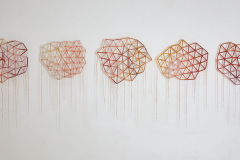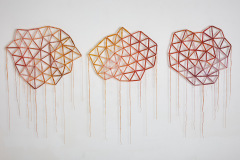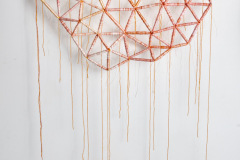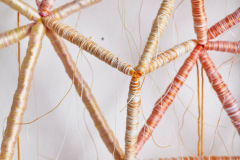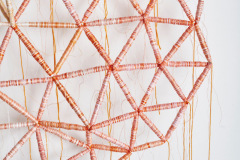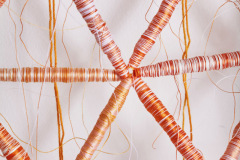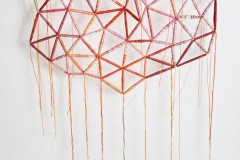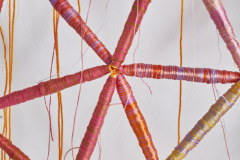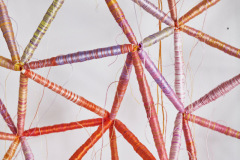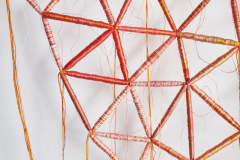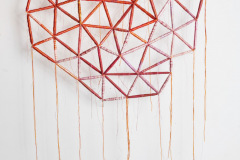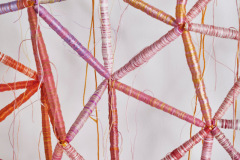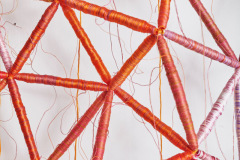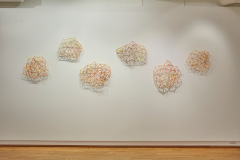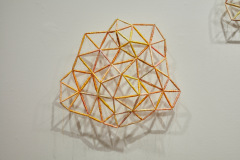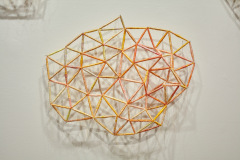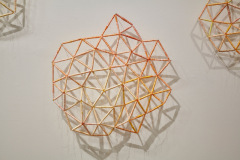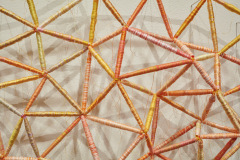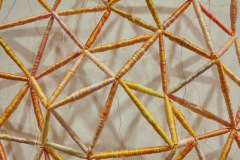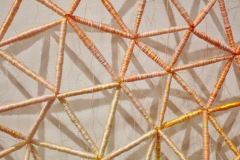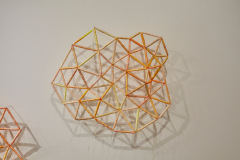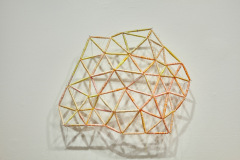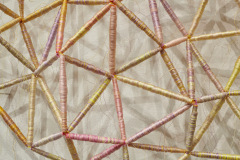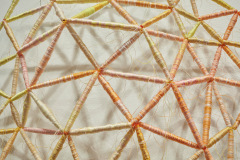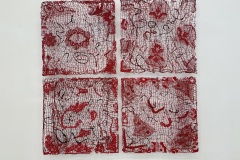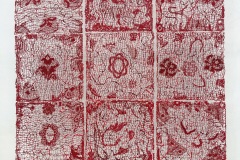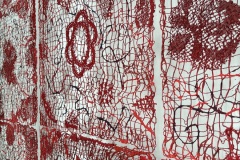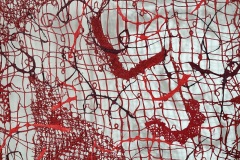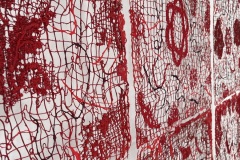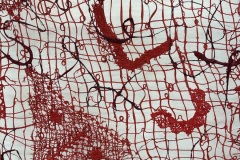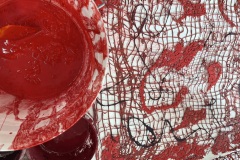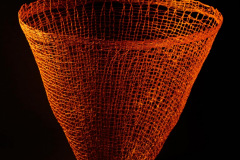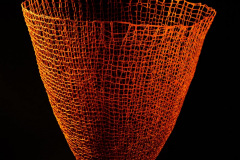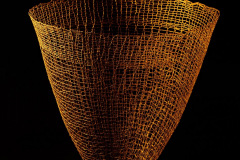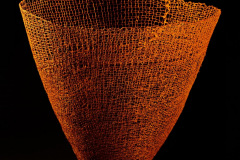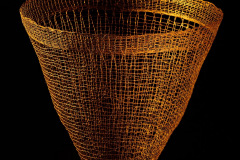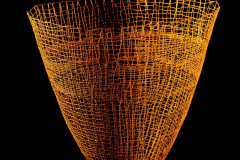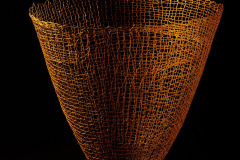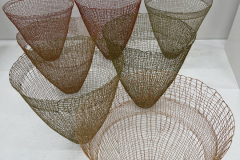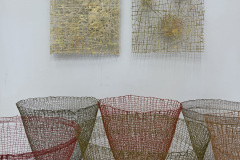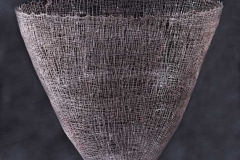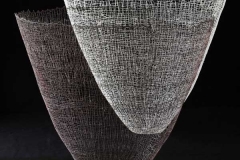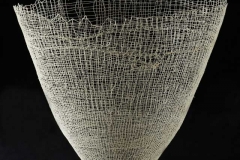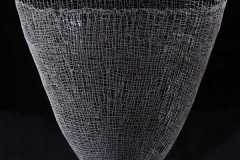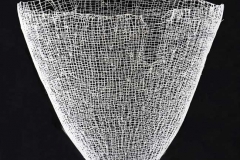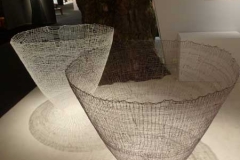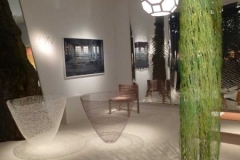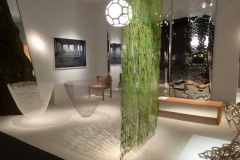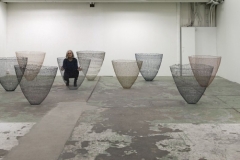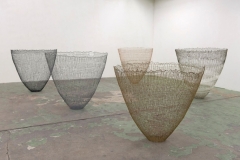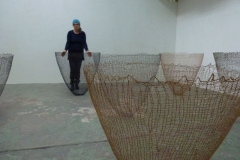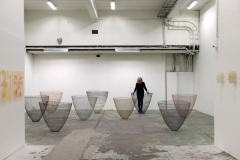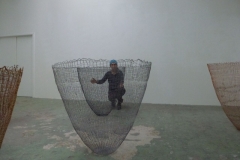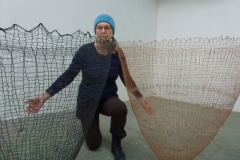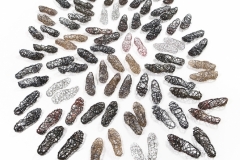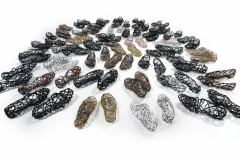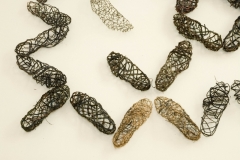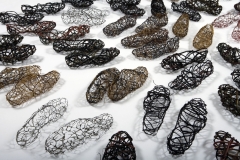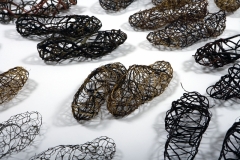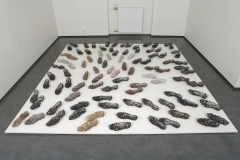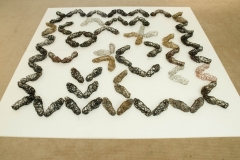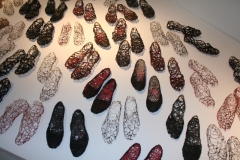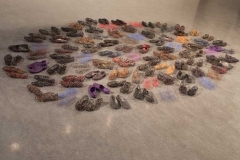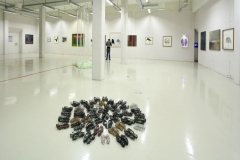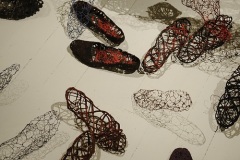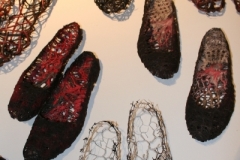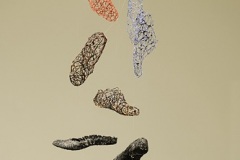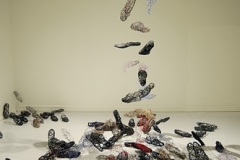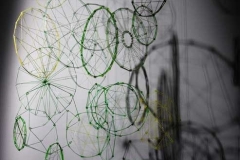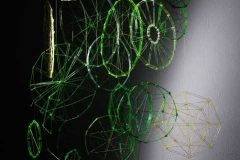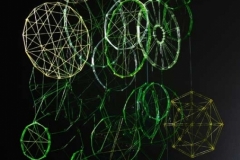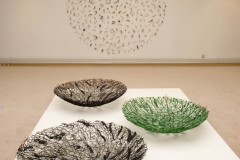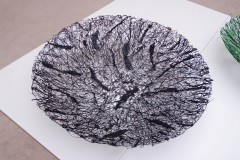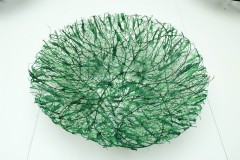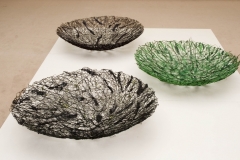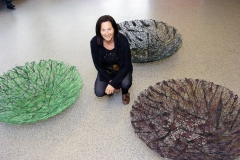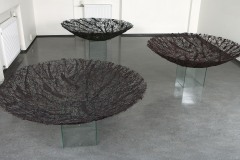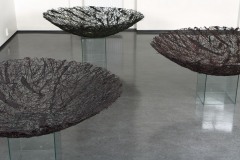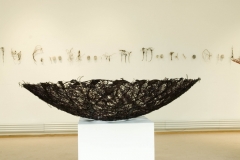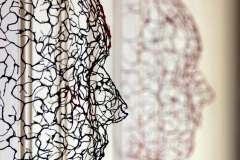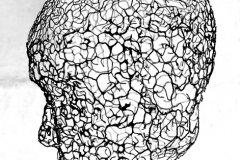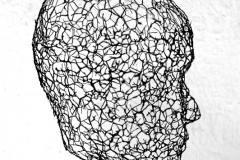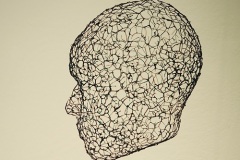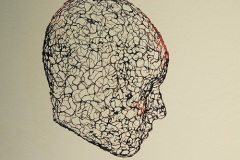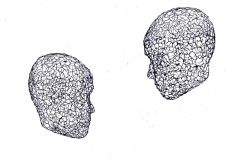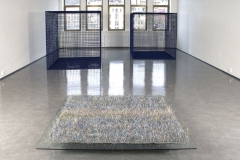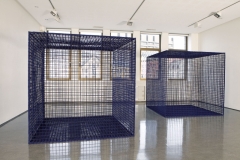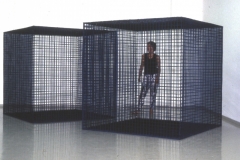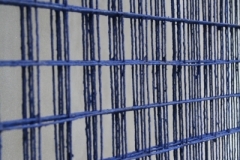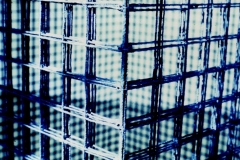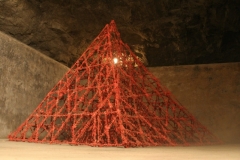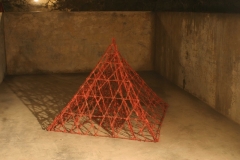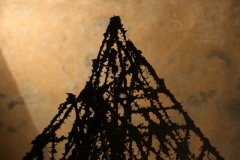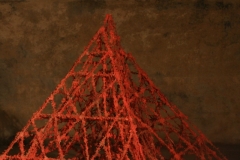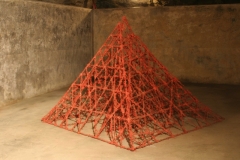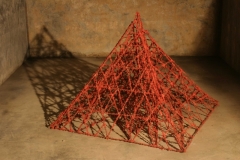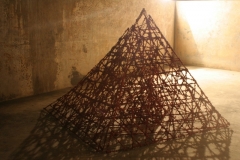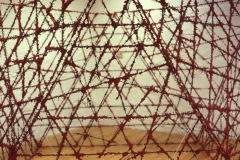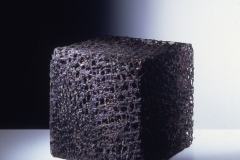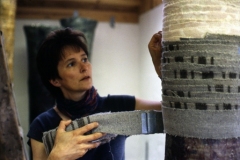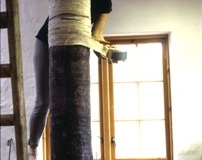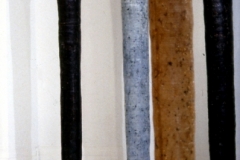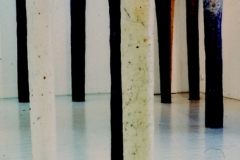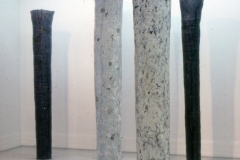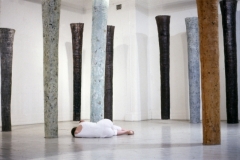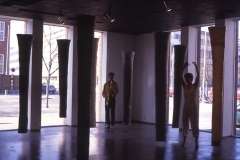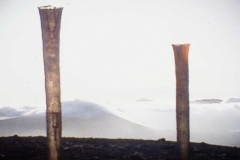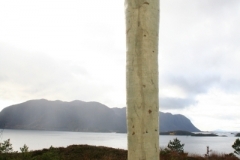Himmeli Red
2023
Wall relieff, series. ( 50 x 60 x 6 cm ) x 5 Straw, cotton and silk thread. Winding and gluing.
Himmeli Yellow
2023
Wall relieff, yellow series ( 50 x 60 x 6 cm) x 6 Straw, cotton and silk thread. Winding and gluing.
The Himmeli series are inspired by the himmelis I have seen in Finland; in museums as well as in private homes.
Himmelis are traditional mobiles made from reeds or straw, hanging from the ceiling over the dinner table. In the farming society its purpose was to ensure a good harvest in the following year; the larger the himmeli the larger the crop!
My himmelis are wall pieces, made from drinking straws and the silk thread I bought in Mumbai way back in time.
Agnus Dei
2020
150 x 150 cm. Crochet, lacework and embroidery techniques, carbon fibers, resin cast.
Agnus Dei was made in the Easter week during the first pandemic year, 2020. Normally my family spend Easter time skiing in the mountain, but this year it was all different:
I was working full time in my studio, listening to the Verdi Requiem, with Agnus Dei, the «Lamb of God» as a central part.
Small Ultima
2021
Diam 60, h 60. Sculpture/installation. Cotton and linen thread, knitting. Resin cast.
Ultima
2014-2015
80-100(h)x95(diam) cm. Natural fibres and resin,
Diam 95-105, h 80-100 cm, series. Sculpture/ Installation. Cotton and linen thread, knitting. Resin cast.
For my solo show in Galerie Maria Wettergren, 2015, Maria Wettergren wrote in the catalogue:
«The title of the present exhibition-ULTIMA- is derived from Gjertrud Hals´ ample eponymous vessels, delicately knitted from cotton and linen threads and hardened with resin. These one-meter tall, featherweight vessels hardly touch the ground. Their size and their lightness contradict each other in certain ways. They seem to levitate and appear almost like a vision. Their ambiguous presence is further enchanted by their incapacity to contain anything (other than themselves) due to their soft, perforated structure. They are self-contained so to speak. Yet, in spite of their delicate transparency they convey a feeling of quiet strength.»
Par/Pair
2007-2014
Ca 25 x 7 x 4 cm each, series. Sculpture/ installation. Roots, wire, fibers.
I began the work Pair upon a residency in Vadsø in Finnmark, also known as Vesisaari, «the capital of the Finns.» For centuries, people have been walking all the way from northern Finland to the northwest coast of Finnmark,as it was easier to find food on the coast.
These exoduses took place from the 16th to the 19th century, during periods of famine. Many of the refugees continued to live on the Finnmark coast, conserving their language and culture. It was a poor life based on austerity, and they had to turn themselves towards nature in order to survive.
I can see the people wandering, especially the women carrying their children, which led me to the shoes, made with roots and metal wire.
Drømmenett / Dream Net
2014
Ca 200×200 cm Fiberglas thread, silk thread, epoxy. Diam 15-45 cm, varying length, series. Sculpture/ installation Fiberglas thread, silk thread, resin.
Dream Net was made as a room installation, the elements hanging from the ceiling in thin threads.
The vivid, moving elements reflect the light and cast shadows on the walls, giving me thoughts on the Native American pow wows I have witnessed.
Urd
2008
Diam 150, d 40 cm, series. Sculpture. Branches, twigs, thread, paper pulp, resin.
After two stays in Finnmark, in 2004 and 2007, the Pasvik taiga made a strong impression. Øvre Pasvik National Park is dominated by Siberian-like taiga, consisting of old-grown pine forest. Coming home, I made this series that relate to nature in a highly direct way, as branches and twigs are incorporated into the works.
The title Urd refers to one of the goddesses in Norse mythology
Ask
2004 – 2014
26 x 15 x 15 cm, series. Sculpture/ Relief. Metal tread, paper pulp.
Ask is shaped as a root net, made on a plaster mold. The mold derives from a mask, made on my sons face when he was a teenager.
Ask deals with mans place in nature, where organic forms attach ties to our own human forms.
The title also refers to the first man in the Norse creation myth; his name was Ask.
Duo
1997
Gjertrud Hals and Helga Bøe
185 x 185 x 185 cm, 2 parts. Sculpture. Linen thread, linen fiber pulp and rabbit skin glue.
Duo is one of the monumental works I made together with Helga Bøe. The cubes are each composed of six equal sides, put together. It was the Norwegian contribution to the 9th Triennial of Tapestry in Lódz, 1998.
Red
1990
200 x 200 cm, h150 cm. Sculpture consisting of seven triangles. Barbed wire, hemp thread, cotton and linen paper pulp.
Red is a monumental red pyramid made of barbed wire, however it has also been exhibited outdoors as a fence.,
I made Red as a memory of World War 2. The island of Aukra, where I lived from 1980-1985, was a military base during the WW2, and the population was forced to move away. The island had an airport, and acted as a gateway to the whole of Romsdalsfjorden region. It was therefore of great strategic importance to the Germans, so it was heavily guarded and surrounded by a barbed wire fence.
However, in1990, 45 years after the end of the war, the barbed wire was still easy to find (!) Red was exhibited at The Erfurt Biennial 1991 and at Gallery F15 in 1992. Since 1998 it has been a part of Ergan Coastal Defences (World War 2 Museum), Bud.
Black Cubes
1990
25 x 25 x 25 cm – 50 x 50 x 50 cm. Sculpture, series, 7 different sizes. Cotton thread, old fishing nets, linen pulp, cellulose glue.
The Black Cubes were made in the way that they could be placed one inside the other, like Russian dolls. They have a simple and repetitive character, and the perforated surfaces contain echoes of fishing nets and crab pots.
It seems like nets is a theme that I will never leave behind. The nets are coming back at intervals, with new variations.
Lyd/Sound
1988-1990
Diam 20/40 x h 280/350 cm Sculpture, series. Polyester, fibres, kozo paper.
With Lyd/Sound I continued the exploration of the frail shell forms and membranes, building on the pure and abstract style that was developed in the Lava vessels. These were my first work with columns, which became another recurring motif in the years to come.
Lyd/Sound consisted of a series monumental columns made of polyester and transparent kozo paper.
They were exhibited indoors as installations, and on some occasions outdoors. They were also used for performances involving dance and music, for instance at Gallery Wang and at the National Museum Of Decorative Arts in Trondheim in the late 80s.
